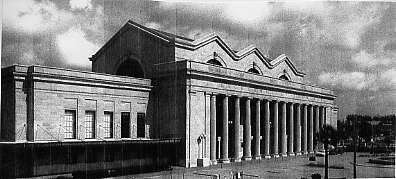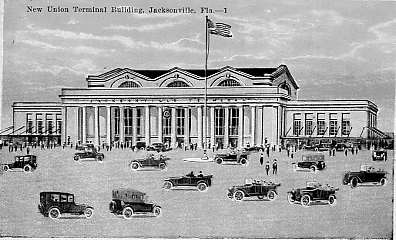
Union Stations Across the U.S.
By Beryl Frank
Jacksonville, Florida
The first train station at Jacksonville, Florida, was built during the winter of 1858-1859 for the Florida, Atlantic & Gulf Central. This included a covered platform with a waiting room, and a blacksmith shop at one end. This was small and not used as much as later platform stations. It was not even a Union station. But it was the first one there.
After the Civil War, a larger enclosed wooden depot was built and became the first 'Union' station. It served more than one railroad when the Waycross Short Line was completed to Jacksonville in 1881 to share the facility with the Florida Central. Now there were two lines using the Florida depot.
But a third train station was to be built in 1883. This was built by the Savannah, Florida & Western line. It included a restaurant, restrooms and an elegant ladies' waiting room with an ornate fireplace. Also, an attendant was always on duty. This was when the newly-completed Jacksonville, Tampa & Key West Railroad began sharing the depot with SF&W. There were now five major railroads serving Jacksonville.
The year was 1893. Henry M. Flagler organized the Jacksonville Terminal Company. He envisioned a Union Depot as a joint venture of all the major railroads serving Jacksonville.
The station was big. It was the classic Spanish mission style and had a covered train shed 150 feet wide and more than the length of three football fields. Although it opened on February 4, 1895, it was not completed until January 15, 1897. The Flagler Depot, so called to honor its builder, was one of the busiest in the nation. By 1912, it was handling as many as 92 trains a day.
Time moved on, and a country-wide contest was held in 1915 to gain plans for a new station, soon to be built. The winner of the competition was the New York City architect Kenneth Mackensie Murcheson.
Murcheson used a beaux arts design and his material was pale limestone-clad reinforced concrete which showed up well in the Florida sunshine. He also designed the classic colonnade of 14 solid limestone-clad columns on the front of the building. These columns measured 42 feet high.
Inside the station was a huge waiting room whose ceiling rose 75 feet above a marble floor. This also served the public as a booking hall. It was cool, but filled with light from tall windows.
Completion of the depot was held up by World War I, but after that war and before World War II, the train depot was completed and accommodated as many as 210 trains a day. The trains did not stop rolling for 55 years.
At the peak of its operation during World War II, as many as 100,000 servicemen and civilians passed through on a busy day. Besides the military personnel, the Jacksonville Terminal brought the famous and the infamous to and from Florida. Al Capone, the Duke and Duchess of Windsor, and Presidents Franklin Roosevelt and Truman were some. Stage and screen personalities also came to the Playground of the South. The Jacksonville Terminal was a success.
Today, trains no longer run through the terminal. A period of vandalism and neglect took over the once elegant building. Airplanes and automobiles replaced the train. But in 1986, the home of 20th century trains became the center of Jacksonville's present convention center. As it once was when still a train station, the building is truly 'magnificent.'

ABOVE.. The Flagler Depot, so called to honor its builder, was one of the busiest in the nation. By 1912, it was handling as many as 92 trains a day.
BELOW.. This depot was completed before WW-II and accommodated as many as 210 trains a day.

.